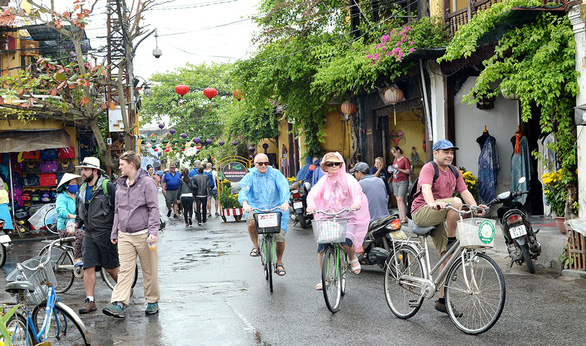As Hoi An handles a massive influx of tourists hoping to experience one of Vietnam’s most well-known destinations, many complain that the ancient town in central Vietnam is at risk of losing its charm and original tranquility, particularly in light of recent incidents including scams targeting foreigners, noisy honking on streets, and the aggressive attitude of many residents.
Hoping to solve the problem, the Hoi An administration implemented a new project called “Hoi An – pure love for people,” encouraging locals to be appreciative, sympathetic, and helpful while also following regulations and protecting the environment.
This message also serves as a reminder to locals that Hoi An, recognized as a world heritage site by UNESCO in 1985, has taken a negative turn and should be preserved in order to maintain its original tranquility.
Deformed Hoi An
Hoi An is most well-known for its well-preserved ancient town, cut through with canals and its reflection on a past consisting of a fusion developed from the 15th-19th centuries when it was one of Southeast Asia’s busiest port towns.
The city has long been one of a favorite destination for many tourists, both Vietnamese and foreigners, thanks to its tranquility, originality, and tradition. It is common for tourists to revisit the town many times over.
However, recently many tourists visiting Hoi An have complained that the city is becoming increasingly stuffy and cramped.
Moreover, many things that were previously perceived as impossible in Hoi An are quickly penetrating the society and seemingly becoming a ‘norm,’ including taxi and xe om (motorbike taxi) drivers ‘robbing’ visitors by charging unreasonable ride fares.
Hoi An welcomes around 3.2 million visitors accounting for nearly VND3,000 billion (US$129 million) in annual tourism revenues.
The explosion in visitors has thus resulted in chaos and created huge interruptions in daily life for both local residents and visiting tourists.
For instance, a transport company in Hoi An was forced to refund tickets to many visitors after being accused of over-charging customers.
Some bus routes connecting Hoi An with the neighboring city of Da Nang have also been the brunt of countless complaints about service-providers taking advantage of visitors’ lack of fluency in Vietnamese by charging them unreasonable prices and confusing them with banknotes of different values, as Vietnamese banknotes with big numbers can easily confuse non-natives.
Reports of a foreign tourist being beaten up by a xe om in Hoi An after a disagreement over prices have recently surfaced on the Internet, sparking a wave of criticism from across the nation.
Many were shocked that such a tranquil place would be a home to such a violent incident.
“In other places, stealing, over-charging, and beating foreign visitors to the point where they need to be hospitalized can happen, but in Hoi An it is unacceptable,” journalist Le Duc Hung from Da Nang said when he learned of the assault in Hoi An.
“Such things not only make Hoi An an unappealing touristic destination, but also offends locals because Hoi An people are not supposed to act aggressively.”
Praise the beautiful values
Hoi An currently has 1,107 traditional houses protected by preservation efforts.
A fourth of these houses are currently being rented or have been bought by non-locals for business purposes.
However, according to Nguyen Chi Trung, director of the Hoi An Center for Cultural Heritage Management and Preservation, this is not the main reason for the recent spate of bad behavior.
It is also important to note that Hoi An has long been a harmony of cultures, an idea that local citizens consider the essence of their local culture.
Nguyen Van Son, the city’s deputy chairman, claimed that the main reason for the controversy is the city’s lack of preparedness for the sudden increase in tourists.
To be more specific, recently, Hoi An has seen an explosion in the number of annual visitors but the number of city and law enforcement officials did not increase, resulting in a lack of resources to maintain order.
In order to preserve the city’s friendliness and purity, the Hoi An administration was determined to establish a city that truly has the “pure love for people” which tourists expect.
“We believe that once we remind people of the nice gestures and the sacred traditional values of the city, the standard behavior such as not honking on the streets, avoiding spitting in public places, and dressing appropriately will be return and once again become a daily practice,” Nguyen Van Son, a Hoi An resident, said.
“Ethics and awareness will have a more long-term effect than laws.”
In addition to preservation, there are still three main challenges that Hoi An currently faces -- internal immigrants from other areas, an overloaded tourism industry, and unpredictable side effects from the city’s development, according to Professor Hoang Dao Kinh.
The professor also went on to praise the city’s new project, stating that thanks to Hoi An’s nature, it is possible to implement such regulations.
Like us on Facebook or follow us on Twitter to get the latest news about Vietnam!


















































